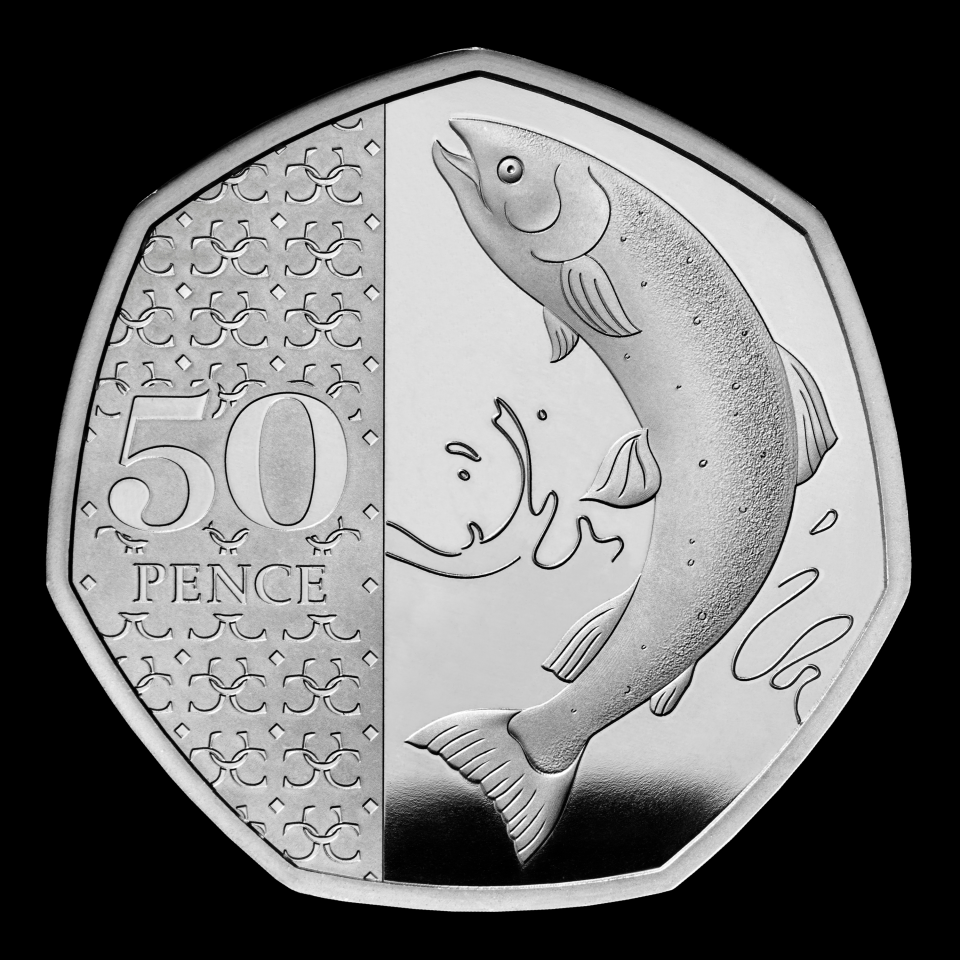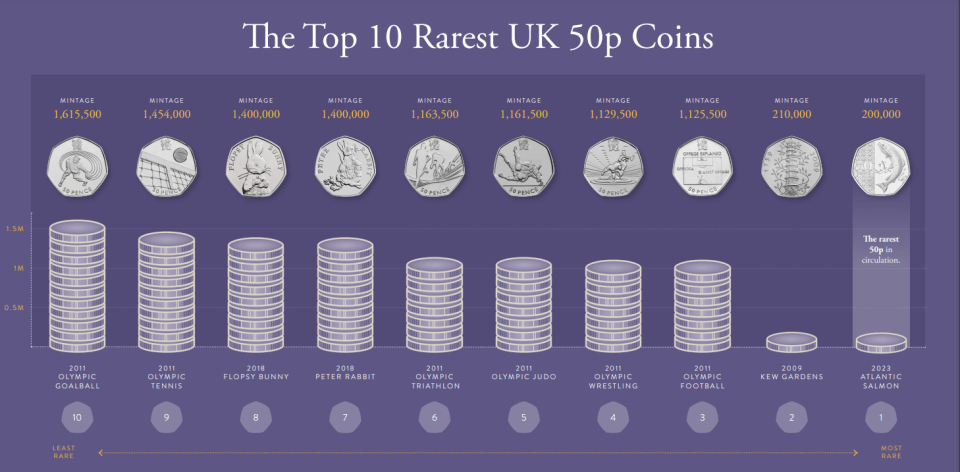A NEW King Charles III coin has officially been crowned the rarest 50p in circulation after kicking another valuable piece off the top spot.
The Royal Mint has exclusively revealed to The Sun the Kew Gardens 50p has been dethroned by the Atlantic Salmon 50p.
The coin was struck to highlight the plight of the species of fish, whose population is in decline.
The 50p piece started entering general circulation at the end of 2023 as part of a new series of coins marking the ascension of King Charles to the throne.
Up until now, The Royal Mint, the official maker of British coins, has yet published confirmed figures on how many of the Atlantic Salmon were put into circulation.
However, it has now revealed 200,000 were sent to banks and post offices across the UK at the end of last year.
There were 210,000 Kew Gardens 50p coins put into circulation 15 years ago which has made it the rarest of the 50ps for over a decade.
But the latest mintage figures from The Royal Mint show its spot has now been taken by the Atlantic Salmon 50p.
Rebecca Morgan, director of commemorative coins at The Royal Mint said: “The releasing of mintage figures is an eagerly anticipated event among the coin collecting community – and this year is particularly exciting as we reveal the Atlantic Salmon as the rarest 50p in circulation.
“For the first time in 15 years, the highly collectable Kew Gardens 50p loses its top spot as the rarest in circulation with the Atlantic Salmon 50p splashing its way to number one.”
Collectors have already been finding the Atlantic Salmon 50p piece hard to come by, with some willing to pay over the odds to get their hands on one.
Plenty of sellers on eBay have found theirs going for multiple times their face value.
In one recent listing, someone managed to sell one of the coins for £51, over 100 times the face value of the piece.
The coin sparked a fierce bidding war, with 23 buyers putting an offer in.
The Atlantic Salmon 50p taking the highest spot for rarest 50p coin in general circulation means the top 10 list is now:
- 2023 Atlantic Salmon – 200,000 made
- 2009 Kew Gardens – 210,000 minted
- 2011 Olympic Football – 1,125,000 minted
- 2011 Olympic Wrestling UK – 1,129,500 minted
- 2011 Olympic Judo – 1,161,500 minted
- 2011 Olympic Triathlon – 1,163,500 minted
- 2018 Peter Rabbit – 1,400,000 minted
- 2018 Flopsy Bunny – 1,400,000 minted
- 2011 Olympic Tennis – 1,454,000 minted
- 2011 Olympic Goalball – 1,615,000 minted
What makes a coin rare?
Rare coins have been known to sell for thousands of pounds in the past with collectors keen to snap them up.
A coin is considered rare usually if it falls into one of two categories – having a low mintage or being an “error” coin.
The mintage of a coin relates to how many of it were struck and put into general circulation.
The lower amount of a coin that was created and is available to the public, the rarer and, potentially, more valuable it is.
A coin may also be classed as rare if there was a mistake made during the manufacturing process which means very few are out there – an error coin.
In some cases, there are just a handful of each error coin for the public to get their hands on making them incredibly rare and valuable.
For example, one error coin dubbed the “lines over face” 50p, has been known to sell for £1,500 in the past.
Other error coins, with incorrect phrasing or dates on, have been known to go for £2,500.
How to sell a rare coin
There are three ways you can sell rare coins – on eBay, Facebook, or in an auction.
If you’re selling on Facebook, there are risks attached.
Some sellers have previously been targeted by scammers who say they want to buy a rare note or coin and ask for money up front to pay for a courier to pick it up.
But the courier is never actually sent and you’re left out of pocket.
Rather than doing this, it’s always best to meet a Facebook seller in person when buying or selling a rare note or coin.
Ensure it’s a public meeting spot that’s in a well-lit area and if you can, avoid using payment links.
Next, you can sell at auction, which is generally the safest option.
You can organise this with The Royal Mint’s Collectors Service.
It has a team of experts who can help you authenticate and value your coin.
You can get in touch via email and a member of the valuation team will get back to you.
You will be charged for the service though – the cost varies depending on the size of your collection.
You can also sell rare coins on eBay.
But always bear in mind, you will only make what the buyer is willing to pay at that time.
You can search for the same note or coin as you have to see how much the same one has sold for on the website previously.
This can help give you an indication of how much you should sell it for.
How to spot valuable items
COMMENTS by Consumer Editor, Alice Grahns:
It’s easy to check if items in your attic are valuable.
As a first step, go on eBay to check what other similar pieces, if not the same, have sold for recently.
Simply search for your item, filter by “sold listings” and toggle by the highest value.
This will give you an idea of how much others are willing to pay for it.
The method can be used for everything ranging from rare coins and notes to stamps, old toys, books and vinyl records – just to mention a few examples.
For coins, online tools from change experts like Coin Hunter are also helpful to see how much it could be worth.
Plus, you can refer to Change Checker’s latest scarcity index update to see which coins are topping the charts.
For especially valuable items, you may want to enlist the help of experts or auction houses.
Do your research first though and be aware of any fees for evaluating your stuff.
As a rule of thumb, rarity and condition are key factors in determining the value of any item.
You’re never guaranteed to make a mint, however.
Do you have a money problem that needs sorting? Get in touch by emailing [email protected].
Plus, you can join our Sun Money Chats and Tips Facebook group to share your tips and stories

